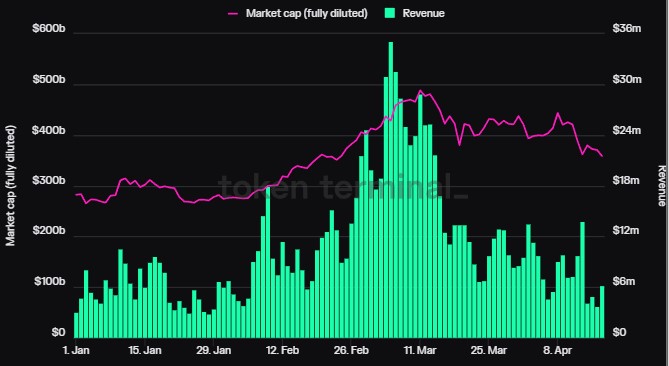Ethereum Blockchain’s Q1 2024 Success: Factors Behind $370 Million Profits Revealed

Not only has Ethereum (ETH) seen an impressive rise of nearly 100% in the first quarter of 2024 in terms of price action, but the Ethereum blockchain has also generated significant revenue worth up to $369 million during this period. This unexpected profitability has raised questions about how blockchains like Ethereum can be profitable.
Ethereum Profit Potential
As noted in a recent analysis by on-chain data platform Token Termina, collecting transaction fees is an important aspect of the Ethereum business model.
All network users must pay fees in ETH when interacting with applications on the blockchain, which is an important source of revenue for Ethereum.
Once the transaction fee is paid, a portion of ETH is burned, permanently removing it from circulation. This process, commonly referred to as “ETH buyback,” benefits existing ETH holders as the supply decrease increases the scarcity and value of the remaining ETH tokens. Therefore, burning ETH daily contributes to the economic benefit of those who hold Ethereum.
In contrast to burning ETH, Ethereum mints new ETH tokens as a reward to network validators for each new block added to the blockchain.
These rewards are similar to traditional stock-based rewards and are designed to incentivize validators to secure and maintain the integrity of the network.
Nonetheless, it is important to note that the issuance of new ETH tokens will dilute the holdings of existing ETH holders.
According to Token Terminal, the difference between the daily USD value of burned ETH (yield) and newly minted ETH (cost) represents the daily earnings of existing ETH holders, i.e. owners of the Ethereum blockchain. This calculation allows you to determine the profitability of Ethereum on a daily basis.
Reduce transaction costs to drive $3.3 billion in growth
In addition to the full-scale revenue model implemented on the Ethereum blockchain, Dencun’s much-anticipated Ethereum ecosystem upgrade, launched at the end of the first quarter of 2024, brings significant changes, including the introduction of an innovative data storage system called Blob. .
This upgrade reduces congestion on the Ethereum network and significantly reduces transaction costs on layer 2 networks such as Arbitrum (ABR), Polygon (MATIC), and Coinbase’s Base.
Implementing the Dencun upgrade along with the adoption of Blob and Layer 2 networks has had a significant impact on Ethereum’s bottom line.
According to Token Terminal data, blockchain revenues grew 18% year over year, reaching an impressive $3.3 billion. These revenue gains can be attributed to lower transaction costs, making Ethereum a more attractive platform for users and developers.

Despite the positive revenue growth, it is important to acknowledge the impact of a market correction and weakening investor interest in the second quarter of 2024.
Over the past 30 days, Ethereum’s revenue has fallen by more than 52%. This slowdown can be attributed to broader market dynamics and a temporary decline in investor enthusiasm.
Looking at data over the past 30 days, Ethereum’s market capitalization (fully diluted) has decreased by 15.2% to $358.47 billion. Likewise, the distribution market capitalization also decreased by 15.2% and reached the same value.
Additionally, over the past 30 days, token trading volume decreased by 18.6%, totaling $586.14 billion.
ETH is trading at $3,042, up 0.4% over the last 24 hours. It remains to be seen whether these changes and fee cuts will have the same effect in the second quarter of this year, and how this, combined with a potential increase in trading volume, could push the price of ETH to higher levels.
Featured image from Shutterstock, chart from TradingView.com



